![]()
![]()
![]()
Use LEFT and RIGHT arrow keys to navigate between flashcards;
Use UP and DOWN arrow keys to flip the card;
H to show hint;
A reads text to speech;
30 Cards in this Set
- Front
- Back
|
What is the tragedy of the commons? |
The tragedy of the commons is a term, probably coined by the Victorian economist William Forster Lloyd[1] and later used by the ecologist Garrett Hardin, to denote a situation where individuals acting independently and rationally according to each other's self-interest behave contrary to the best interests of the whole by depleting some common resource. |
|
|
What is the difference between kinetic and potential energy? |
Potential energy is the stored energy in an object due of its position or its configuration whereas Kinetic energy is the energy which a body possesses because of its motion. |
|
|
How does heat flow and describe the flow of energy. |
Heat transfer is the exchange of thermal energy between physical systems, depending on the temperature and pressure, by dissipating heat. The fundamental modes of heat transfer are conduction or diffusion, convection and radiation. |
|
|
What are the first and second laws of thermodynamics? |
The first law, also known as Law of Conservation of Energy, states that energy cannot be created or destroyed in a chemical reaction. The second law of thermodynamics states that the entropy of any isolated system not in thermal equilibrium almost always increases. |
|
|
What is the difference between positive and negative feedback loops? |
In a feedback loop the product of a process, such as the breakdown of proteins into amino acids, has an effect on the rate of the process. Negative feedback occurs when the rate of the process decreases as the concentration of the product increases. Positive feedback occurs when the rate of a process increases as the concentration of the product increases. Negative feedback controls the rate of a process to avoid accumulation of a product. The rate of a process will continuously accelerate under positive feedback as long as substrate is available and the product is not consumed by some other process. |
|
|
What is matter? |
physical substance in general, as distinct from mind and spirit; (in physics) that which occupies space and possesses rest mass, especially as distinct from energy. |
|
|
What does it mean to be sustainable? |
able to be maintained at a certain rate or level. |
|
|
What is the distribution of Earth's water percent's? |
2.5% of Earth's water is freshwater. Only a little more than 1.2% of all freshwater is surface water, which serves most of life's needs.20.9% is found in lakes. rivers make up 0.49% of surface freshwater. |
|
|
Who uses the most water in the United States? |
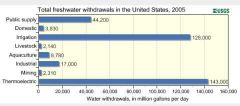
|
|
|
Who worldwide uses the most water? |
Skip |
|
|
Water distribution management |
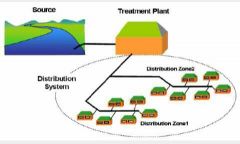
|
|
|
What are the water issues in the western US? |
Colorado river: running dry California: Drought Columbia/snake river: lack of comprehensive quality |
|
|
What is happening with the Aral Sea? |
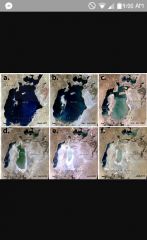
|
|
|
What are the greatest issues facing the great lakes? |
Invasive mussels, quagga and zebra mussels.Risk of new invasive species from ships’ ballast water tanks.Coastal development.Non-point source pollution, particularly phosphorus, which contributes to toxic algae blooms.Invasive fish, such as the round goby.Climate change causing warmer temperatures in the Great Lakes basin.Climate change affecting water levels.Sea lamprey |
|
|
What is the issue facing the Ogallala aquifer? |
Today the water of the Ogallala aquifer is severely degraded in terms of quantity and quality, which has large-scale implications for America’s economic productivity |
|
|
What are the pros and cons of using dams? |
A dams is a barrier that impounds water, whether it be on the surface or underground in caves. It pushes water back and is often use to store water because it creates a large area from where water cannot escape. However, it can also be used to create hydroelectricity because of the power it gives the water when it pushes back. They are often used for a massive water flow where they can prevent floods, store water and create electricity using only one dam. |
|
|
What is the difference between point and non-point-point source pollution? |
Point source pollution results when the contaminants come from a single location. Examples of point source pollution in the air, water and soil are given below.Air. A certain factory is producing chemicals. As part of the manufacturing process, certain poisonous chemicals and toxic gases result, such as benzene. The chemical company permits these toxins to be released from the stack at the factory without treating them. The untreated, toxic chemicals are released directly into the air.Water. A company has a new tank. This tank is being treated with a special chemical. Non-point-source pollution results when contaminants are introduced into the environment over a large, widespread area. Some examples follow. |
|
|
What do you use to test the quality of water? What tools do we use? |
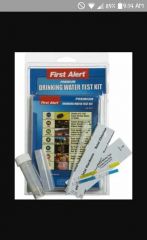
|
|
|
What are the issues with the use of fertilizers (nitrogen and phosphorus)? |
-Excess nutrients can impact water quality when it rains or when water and soil containing nitrogen and phosphorus wash into nearby waters or leach into ground waters -he nitrogen from fertilizers and manures are eventually converted by bacteria in the soil to nitrates. These nitrates can be leached into the groundwater or be washed out of the soil surface into streams and rivers. High nitrate levels in drinking water are considered to be dangerous to human health. |
|
|
How does a sewage treatment plant work? |
The Sewage Treatment Plant process is similar to the way that a Septic Tank works but mechanical components provide a process to help break down solids to produce a cleaner, more environmentally friendly effluent. |
|
|
What is eutrophication? |
excessive richness of nutrients in a lake or other body of water, frequently due to runoff from the land, which causes a dense growth of plant life and death of animal life from lack of oxygen. |
|
|
What organisms are responsible for disease in water? |
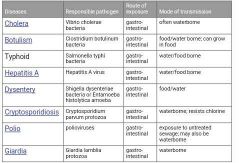
|
|
|
What can cause groundwater contamination? |
Groundwater contamination occurs when man-made products such as gasoline, oil, road salts and chemicals get into the groundwater and cause it to become unsafe and unfit for human use. |
|
|
What is the clean water act? |
Clean Water Act (CWA) is the primary federal law in the United States governing water pollution. |
|
|
What are some historic oil spills? What damage did they cause? |
The gulf of mexico |
|
|
What are the freshwater and saltwater biomes and breakdown of lake and ocean zone? |
Water is the common link among the five biomes and it makes up the largest part of the biosphere, covering nearly 75% of the Earth’s surface. Aquatic regions house numerous species of plants and animals, both large and small. In fact, this is where life began billions of years ago when amino acids first started to come together. Without water, most life forms would be unable to sustain themselves and the Earth would be a barren, desert-like place. Although water temperatures can vary widely, aquatic areas tend to be more humid and the air temperature on the cooler side.The aquatic biome can be broken down into two basic regions, freshwater (i.e, ponds and rivers) and marine (i.e, oceans and estuaries). |
|
|
What are the many types of estuaries and wetlands? |
Coastal WetlandsCoastal wetlands are found in the areas between land and open sea that are not influenced by rivers such as. shorelines, beaches, mangroves and coral reefs.A good example are the mangrove swamps found in sheltered tropical coastal areas. The partly submerged roots of mangrove trees spread out beneath the water to trap sediment and prevent it being washed out to sea. Around 70% of tropical coastlines are mangrove-lined.Some mangroves are strategically planted between land and sea to stabilise shores and to protect communities from violent storms and powerful waves. The result is an area of stillness and tranquillity where fish breed, wildlife takes refuge, and local people earn a living from occupations as diverse as charcoal burning and bee keeping.Shallow lakes and pondsThese wetlands are areas of permanent or semi-permanent water with little flow. They include vernal ponds, spring pools, salt lakes and volcanic crater lakes. They are small, shallow, intermittently flooded depressions in grasslands or forests, and are often only wet in winter and early spring. © WWF / Terry DOMICO© WWF / Terry DOMICOCOASTAL WETLANDSSundarbans MangrovesGulf of Guinea MangrovesMadagascar MangrovesBogsBogs are waterlogged peatlands in old lake basins or depressions in the landscape. Almost all water in bogs comes from rainfall. Bogs have specialised and unique flora that have evolved in their nutrient-poor and acidic conditions, including for example the carnivorous pitcher plant. As bogs are unsuitable for agriculture, forestry or development they offer an undisturbed habitat for a wide range of species, including moose, black bear, lynx, snowshoe hare and mink.In addition, bogs are used by many species of migratory birds, providing a safe habitat in which to breed, rest and feed. A particular kind of bog is found on the coastal plain of the southeasteern United States. Pocosins are evergreen shrub bogs typically found on high areas of a flat water-logged landscape. © Michèle Dépraz / WWF© Michèle Dépraz / WWFPEAT BOGSNorthern Andes WetlandsMarshes and SwampsAlso known as palustrine wetlands, marshes, swamps and fens account for almost half of all wetlands throughout the world.Marshes are one of the broadest categories of wetlands and in general harbour the greatest biological diversity. Marshes form in depressions in the landscape, as fringes around lakes, and along slow-flowing streams and rivers. Marshes are dominated by floating-leafed plants like water lillies and duckweed.Marshes slow down the rate of rainfall drainage and control its flow into rivers, lakes, and streams.EstuariesThe area where rivers meet the sea and water changes from fresh to salt can offer an extremely rich mix of biodiversity.These wetlands include deltas, tidal mudflats and salt marshes. Mudflats and seagrass beds in particular provide a rich diet for many species of insects, birds, fish, turtles and other species. © WWF-Brazil/Zig KOCH© WWF-Brazil/Zig KOCHMARSHLANDS AND ESTUARIESMesopotamian Delta and MarshesChesapeake BayWWF'S WORKWWF works around the world to preserve wetlands, working in partnership with NGOs, local communities and across government borders.It engages in a wide variety of projects to protect habitats and conserve these vital ecosystems.Examples include:Danube Delta: A Natural Gateway to EuropeMangrove Conservation in Western MadagascarSupporting Conservation of Asian ForestsMAKE A DONATION $5 $10 $20 $ Donate now DID YOU KNOW?The Ramsar Convention identifies a grand total of 42 different types of wetlands. It splits these into 3 broad categories: marine and coastal wetlands; inland wetlands; and manmade wetlands. © RamsarespañolCRITICAL SPECIESPRIORITY PLACES & HABITATSGLOBAL SOLUTIONSCONSERVATION HIGHLIGHTS Two Siberian tigers (Panthera tigris altaica)Tigers African elephant sub-adults play fighting, Dzanga-Ndoki National Park, Central African Republic.Elephants Rhinos Mountain gorillas, Virunga National Park, Democratic Republic of CongoGorilla pandasGiant panda Marine turtlesSUBSCRIBE TO OUR MAILING LISTEmail address(*)SubscribePrivacy Policy We need your supportSEE ALL WWF GIFTSGorgon's head Gorgonocephalus caputmedusae in the Selligrunnen, a protected cold-water coral reef in the Trongheimsfjorden, Norway.Help prevent a coral catastropheFight the destructive harvesting and unregulated trade of one of the most attractive inhabitants of our tropical oceans.Help prevent a coral catastropheor see all WWF giftspreviousnextBuilding a future in which humans live in harmony with nature.Using & Sharing Site ContentWeb ToolsContactFeedbackPrivacySite EtiquetteSite MapRSS/Web Feeds© 2015 WWF – World Wide Fund For Nature (also known as World Wildlife Fund) Creative Commons licence. |
|
|
What is the role of plankton in oceans? |
Plankton play a key role in the oceanic food web ... Photosynthesis by the phytoplankton accounts for up to half of global primary production. They also provide the primary food source for the zooplankton, and together form the base of the oceanic food chain. Larger and larger zooplankton, fish, and mammals depend on these plankton for their survival. Tying it all together, the bacterioplankton play an important role in the recycling and remineralization of materials and energy within the food chain. |
|
|
What are some issues with coral reefs? What does it take to create a coral reef? |
The majority of reef loss or damage is not deliberate. Coral reefs are being degraded by an accumulation of stresses arising from human activities. In simple terms, stresses can be grouped by the actions of people extracting material from, and placing materials upon, coral reefs. Overfishing, pollution and coastal development top the list of chronic stressors. In many situations chronic stresses are overwhelming the resilience, (or the capacity for self-repair), of reef communities. Some coral reefs are covered with sand, rock and concrete to make cheap land and stimulate economic development. Others are dredged or blasted for their limestone or to improve navigational access and safety. In addition to this, long-term changes in the oceans and atmosphere (rising sea temperatures and levels of CO2), and acute stresses from highly variable seasons, severe storms, earthquakes and volcanic eruptions also affect coral reefs. |
|
|
What is Mitigation Banking? |
Mitigation banking is the preservation, enhancement, restoration or creation (PERC) of a wetland, stream, or habitat conservation area which offsets, or compensates for, expected adverse impacts to similar nearby ecosystems. |

